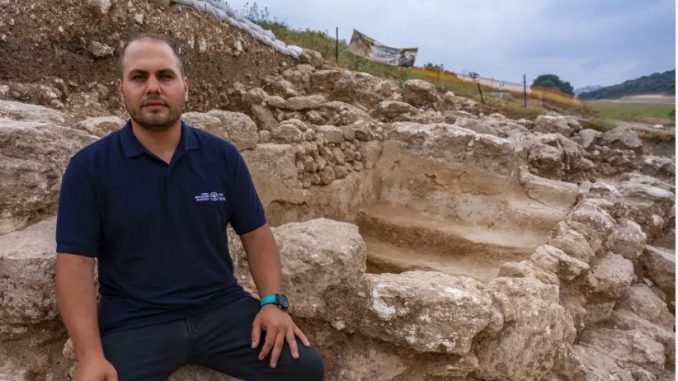
An ancient ritual bath makes the journey to his new home, a kibbutz.
The kibbutz campaign triumphs in an attempt to shelter ancient Mikveh
A 2,000-year-old ritual bath (mikveh), which provides the first significant evidence of the existence of Jewish farms in Galilee during the Second Temple period, was transferred on Tuesday to Kibbutz Hannaton in Galilee.
The old facility was uncovered during a salvage excavation by the Israeli Antiquities Authority for the construction of a new road intersection near Kibbutz Hannaton and had to be destroyed. The workers had discovered the remains of a Jewish agricultural farm dating from the Second Temple period, including this well-preserved mikveh . The excavations were carried out with the help of workers from the village of Kfar Manda, students from pre-military preparatory programs and volunteers from the surrounding area, including inhabitants of Kibbutz Hannaton.
Kibbutz residents launched a participatory fundraising campaign to save the ancient mikve and place it next to the modern, functional mikve in the religiously pluralistic kibbutz earlier this year,
With the support of the AAI, the Ministry of Jerusalem and Heritage, Netivei Israel, the Jezreel Valley Regional Council and the inhabitants of the kibbutz, the campaign raised the funds needed to move the ancient mikveh.
According to Abd Elghani Ibrahim and Dr. Walid Atrash, directors of the excavations on behalf of the IAA, “the existence of a mikveh, a purification facility, indicates unequivocally that the inhabitants of the old farm were Jews, who ran a religious and traditional organization. and maintained purity as a commandment of the Torah. Ritual baths were used in the daily life of the Jews from the period of the Second Temple to the present day”.
Ibrahim and Atrash also noted: “The discovery of the Mikveh in the farmhouse changes what we thought we knew about the Jewish way of life in the Second Temple period”.
Until now, we had not discovered any Jewish farms in Galilee. It was considered that Jews in Roman times did not live on farms but in villages or towns. The discovery of the farm at some distance from the village of Shikhin and the large Jewish town of Sepphoris, showed that Jews also settled on farms, which perhaps functioned as the rural hinterland.
About 1700 years have passed since the farm was destroyed by an earthquake and about 1400 years since the site was completely abandoned.
Recently, work has begun on the construction of a large road interchange over the valley and deep foundation trenches have been built in the bedrock to anchor one of the bridge’s support columns.
While archaeologists were excavating next to the construction work, the mikveh was discovered. As it was not possible to preserve the mikveh on the site, the archaeologists proposed the idea of detaching the installation from the rock and transplanting it to a protected site for an exhibition for the benefit of the public.
Over the past week, preparatory work for the transfer has been carried out. The mikveh, which weighs around 57 tonnes, was sawn on all sides, detached from the bedrock and surrounded by a steel cage to protect it and allow it to be hoisted. On Tuesday, as the inhabitants applauded, it was hoisted into the air and carefully deposited in its new location.
Archaeologists have been able to date the Mikveh to the Second Temple period thanks to the grey plaster covering the pool and the width of the staircase leading to it. It is believed that the culture of the area at that time was mainly olive trees or vineyards producing the high quality oil or wine used in the temple. For this reason, the ritual bath could have been used by the farmers, who needed to immerse themselves constantly to avoid making the products unclean.
Similar cases are discussed in the Mishna, the founding text of rabbinic Judaism, which will be compiled in the nearby town of Tzipori some 200 years later.
“From the hill we can see Tzipori as well as Nazareth which is also about 20 minutes away,” said Anat Harrel, a tour guide and member of the kibbutz’s mikve committee. “I often guide Christian tourists and this mikveh dates back to the time of Jesus. Could we tell them that he may have visited this field and spoken to the farmers who used this mikveh?
Other ritual baths from the Second Temple period have been found throughout Israel in recent years. In 2015, during archaeological excavations in an underground cave on the site of a planned kindergarten in Jerusalem, researchers found a ritual bath and an antechamber, decorated with inscriptions and wall paintings. Earlier that year, a family in Jerusalem’s Ein Kerem neighborhood discovered an ancient ritual bath while renovating their home.
Rossella Tercatin contributed to this report.
Source: Alliance Mag

Be the first to comment